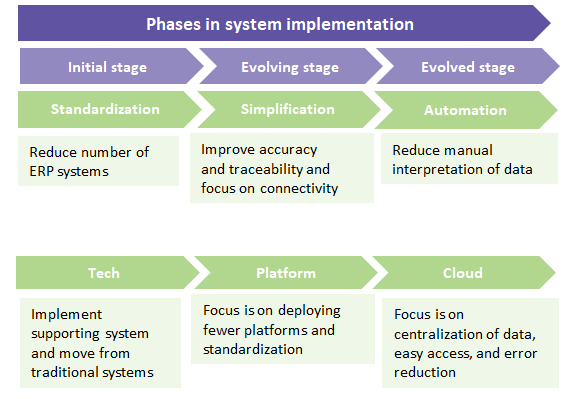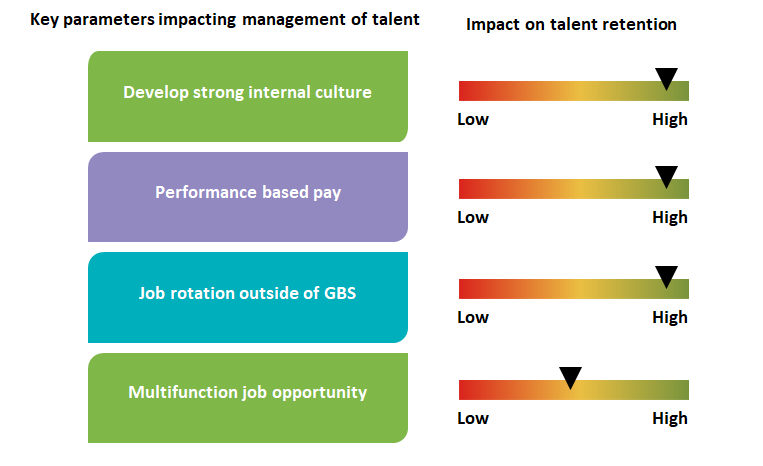
System Integration is the Key Enabler for Global Business Services


The concept of shared services center (SSC) is not new. The move of transactional process into back office centers have given significant leveragability and resource utilization to companies. Now that the low hanging fruits have been plucked, companies are looking at options to further strengthen this existing infrastructure.
The major issue that most companies still face is a lack of communication between regions/business units (BUs). Only in centralized companies, where the strategies are made at a central level, there is some degree of visibility. Global business services (GBS) can address this challenge. A move from SSC to GBS requires robust technological deployment, talent management, and governance policies backed by a solid C-level push. The objective is centralization of process ownership, governance, leadership, service management, technology, infrastructure, talent development model along with continuous improvement. GBS can have a multi-location setup.
Recommendation
Best in class companies follow a phased approach for moving from an SSC to a GBS as it allows time for implementing change and getting the organization prepared. System integration is the key enabler for GBS implementation. Change management and talent retention policies can drive the success of GBS.
A global business services (GBS) is a global operating model used to organize, deliver, and continuously improve internal business services provided to support value producing processes and business units. As organizations scale up, GBS implementations become more common.
After the success of SSC, companies now look for the next big transition—GBS.
GBS requires a common framework for people-process-systems. It is a transformational journey from SSC, where this level of standardization starts. Moreover, this transformation allows teams and employees to prepare well regarding the processes and system changes.
Many companies struggle to standardize and stay at the SSC stage. However, companies with a definite vision go on to achieve GBS status with planning and C-level support. However, without an existing SSC, gaining the status of GBS is challenging.
Objectives for moving towards GBS:
-
Customer-centricity
-
Global governance and integration of policies
-
End-to-end process management/standardization
-
Reducing functional silos and bringing innovation in people-process-system aspect
Issues/Challenges in transition from SSC to GBS
The major challenges faced in the transition from SSC to GBS are:
-
Lack of C-level buy-in. Eight out of ten initiatives fail if the top management support and push is missing.
-
Process and governance issues, such as lack of robust change management program.
-
Back office status and lack of end-to-end process transfer. Often, the role of the SSC is not clear to the BU. Hence, strategic processes are kept outside of the SSC.
Apart from these issues, there are other factors, such as:
-
Internal politics
-
Functional silos
-
Multiple technology platforms
-
Bureaucratic decision making
-
Resource limitations
-
Opposition to cross-location and cross-business unit process ownership
Dealing with the transition—key factors at different stages
(People-Process-System perspective for different models of GBS)
|
Parameter |
Sub-parameter |
Initial stage—Cost Cutting |
Evolving stage—Excellence generation |
Evolved stage—Value Creation |
|
Process |
Focus |
Function |
Process |
Customer Process |
|
Operation scope |
Single function transaction level |
Multi function Both transaction and operation level |
Multi function,transaction, operation, and strategic level |
|
|
Performance |
Cost focus |
Cost Quality |
Cost Quality Value |
|
|
People |
Key talent |
Functional coordinators/ influencer |
Global process owners |
Global process owners Global strategic leader |
|
Goal |
Follow policies |
Focus on business partnership (with BU) |
Focus on customer delight |
|
|
Skill training target |
Target error reduction and improve efficiency |
Decision support |
Advisory role |
|
|
Governance |
Functional level |
Functional level Local/ regional |
Cross functional level Global |
|
|
System |
Standardization level |
Limited/local |
Region/geography |
Enterprise/ global |
|
Implementation |
Macro, Excel |
AI, RPA |
Blockchain |
Systems approach for transition into GBS
-
Most of the F500 companies have started investing in advanced technology, such as AI, chat-bots, and automation.
-
Currently, full-fledged utilization of these technologies is used only in certain cases; however, the industry is moving towards implementing these technologies in GBS. The deployment of advanced technology depends on the maturity of the existing technology and the need for advancement according to the vision of GBS program. Technologies, like cloud, automation, etc. would be used fully in the next 5–8 years.
People and process aspect of the transition from SSC to GBS:
The key success factor for GBS is an exceptional talent base. Since service delivery is the key distinguishing factor between an SSC and a GBS, better talent leads to better process management and innovation.
The key mechanisms to ensure governance and smooth functioning of GBS include customer satisfaction surveys and steering committees with senior management from the business.
Process initiatives essential for success of GBS:
-
Steering committee is strategic in nature and essential to drive the overall GBS initiative from the process-people-system perspective
-
Change management is under the steering team and allows employees to understand the move to the new processes and acts as a support system to deal with any people issues
-
Communication plan is useful to keep the employees informed and motivated regarding the change
Choosing location for establishing GBS
Companies with a major focus on cost reduction tend to establish the GBS in a location where labor arbitrage is possible. However, companies that are already established in systems tend to locate the GBS where the quality of talent is better and the time zone is more compatible.
|
Labor arbitrage |
Labor arbitrage of up to 40–45 percent is possible via GBS. Low-cost destinations offer the best labor arbitrage. |
|
Talent/labor quality |
Labor quality is a critical metric to evaluate service delivery deployment strategy |
|
Regulatory/legal understanding |
Understanding regulatory norms helps in avoiding unnecessary legal hassles related to employment/termination/taxes etc. |
|
Time zone compatibility |
Best in class companies consider proximity to headquarters while setting up new SSCs, to leverage similar time zones and ease of travel |
Case study: Leading metals and mining company
The company is currently moving towards a GBS from an SSC structure. Due to lack of end-to-end process ownership, the SSC is facing challenges with regards to process innovation. Since, the establishment is in a low-cost country, labor arbitrage is the primary reason for achieving benefits.
|
Reporting structure |
|
|
Model |
|
|
Activities |
|
|
People management |
|
|
Process changes |
|
|
System consideration |
|
|
Benefits achieved |
|
Conclusion
GBS heavily gains from process improvement. A move from SSC to GBS would mean better alignment with the business strategy. Consolidation drives economies of scale. A global approach improves visibility, control, and risk management.
Through the development of common processes, policies and procedures, standardized documentation, use of core technology (including ERP), aligned objectives, and leveraging of organization-wide relevant best practices, services and business engagement can be improved in a way that is practical and achievable.
Related Insights:
View All
Get more stories like this
Subscirbe for more news,updates and insights from Beroe








